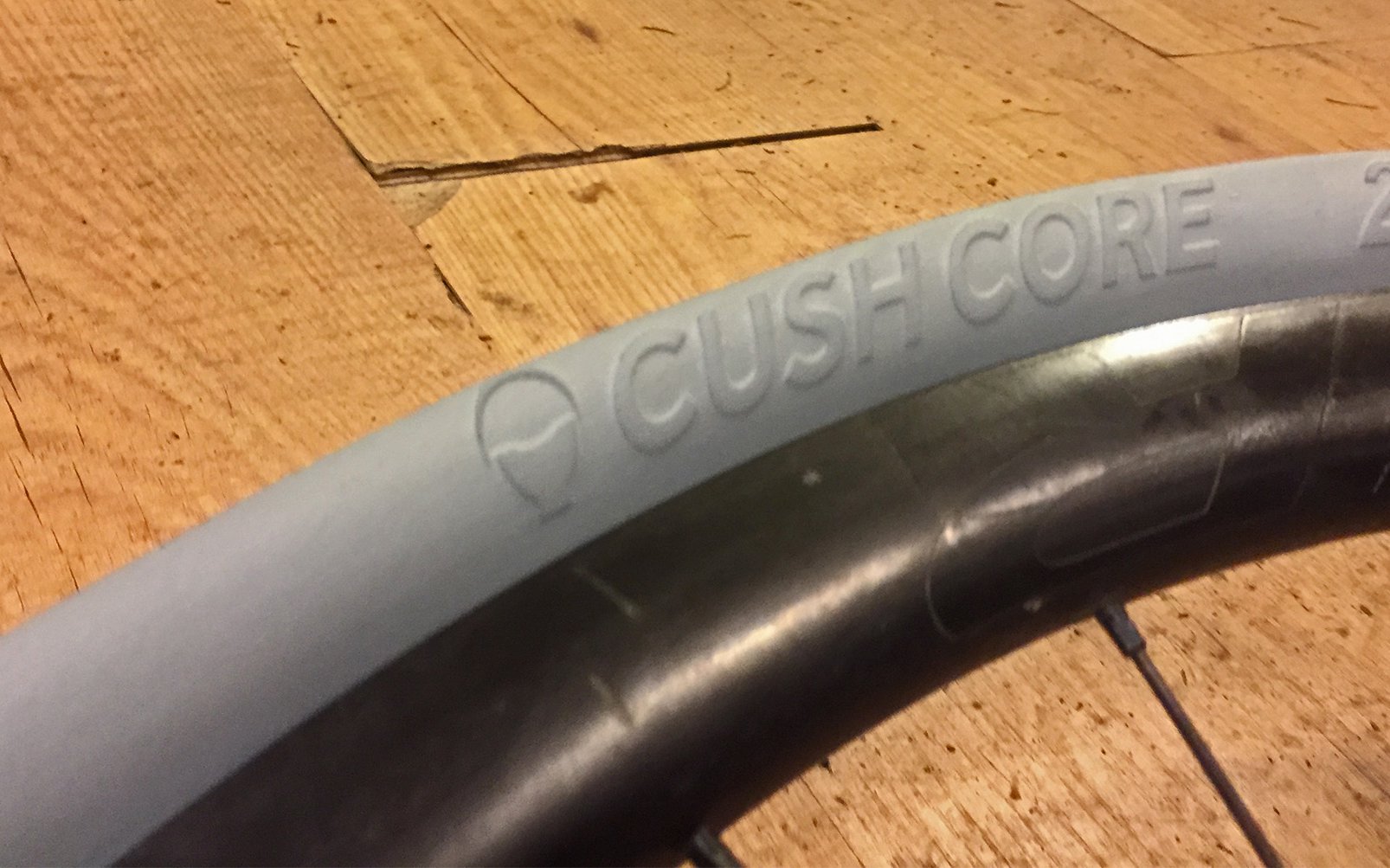
Protection from Dings and Flats
Cushcore - Another Ding and Flat Solution
Similar to other foam inserts like Flat Tire Defender, Huck Norris and Schwalbe's ProCore pneumatic insert, Cushcore is designed to prevent flats and protect your rim. Cushcore's claims go next level though and the product is said to improve sidewall support, vibration damping and probably to turn baby heads into loam. Cushcore's claim chart is below. We haven't yet had enough time on any of these products (aside from ProCore) to back up or shoot down any of these.
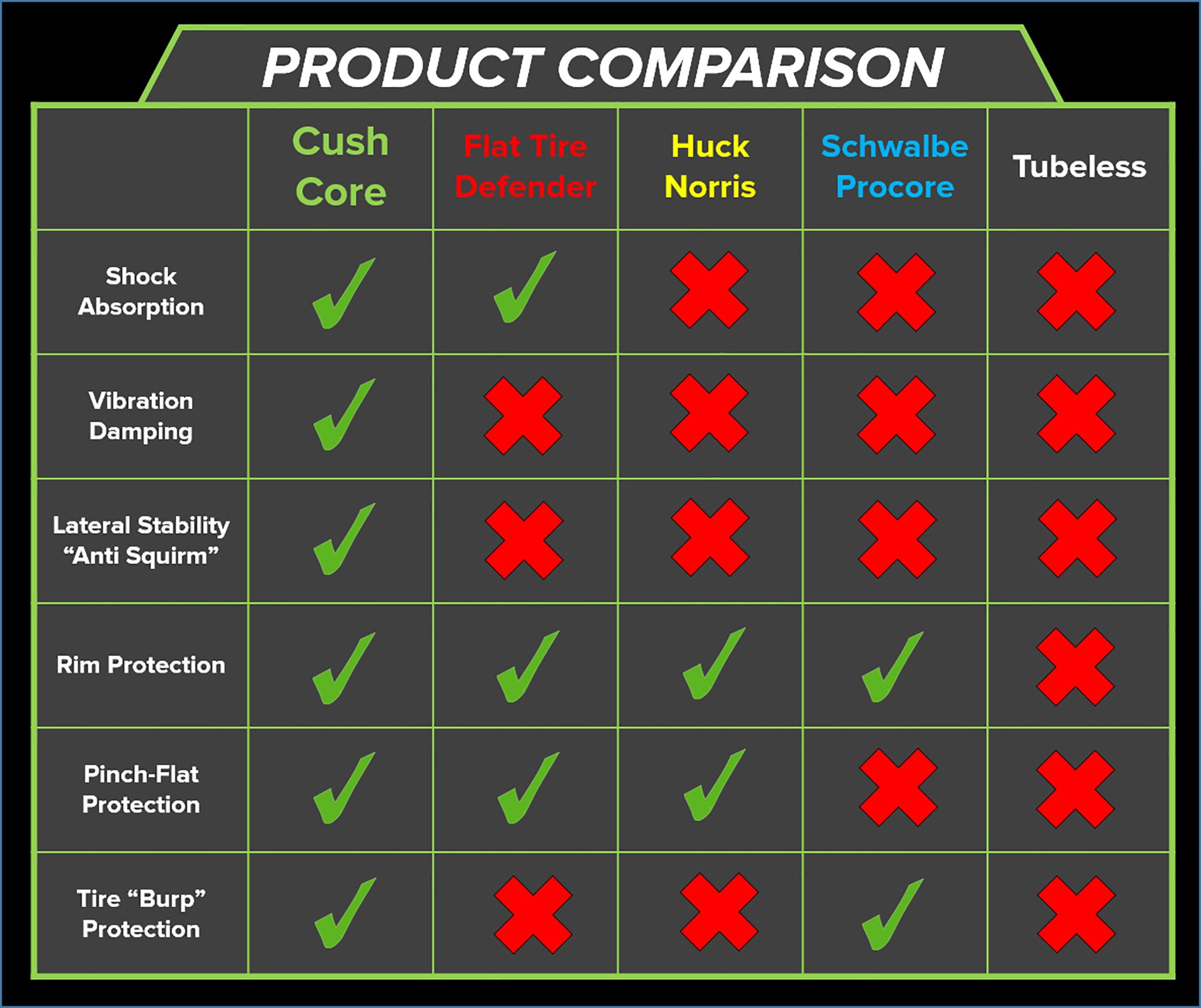
Cushcore produced this chart. Is this all true? We don't know yet whether this product does what it says and (aside from ProCore which we have tested) if their verdicts about the other products are accurate either.
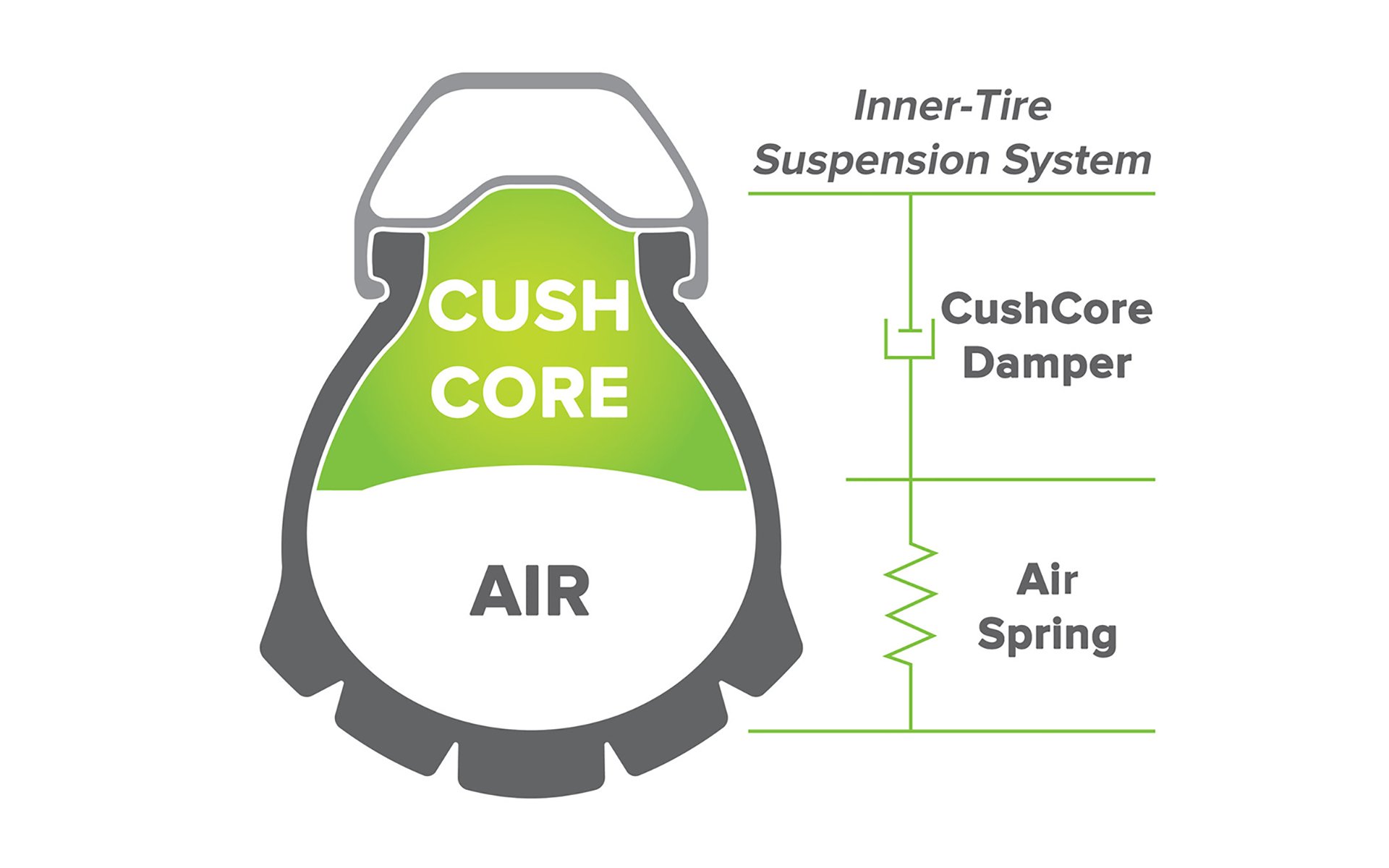
Cushcore's unique shape can be seen best in cross-section, which resembles a tea cup. It fits into the rim channel and then rests against the bead and sidewall of the tire but is recessed in the middle.
It was going to be a long night. I finally worked up the nerve to install Cushcore inserts into my tightest fitting rims and things went immediately sideways. I've mounted a few different tires onto our Bontrager Line XXX carbon test wheels and they are certainly tougher than most, but when a tube is required they become vicious. The inner channel is a little narrow and Bontrager uses their own TLR rim strips rather than messy tape to seal the spoke holes. These strips are a little thicker than tape and they have a built up area around the valve hole, further reducing the circumference and width of the channel. And this area was turning into a problem before I even started to install the insert, let alone the tire.
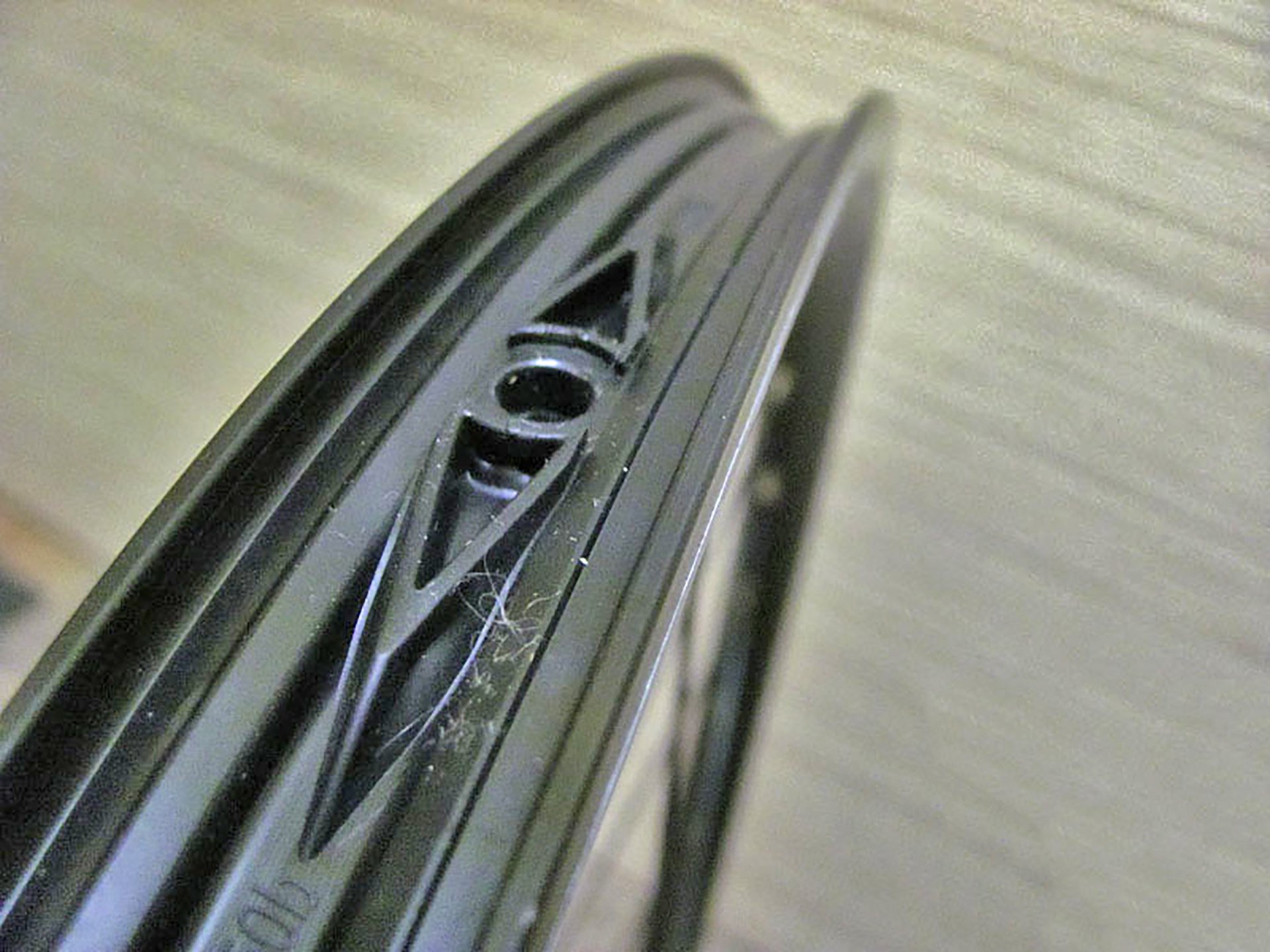
Bontrager's TLR rimstrips were not my friend in this case - or at least this extruded structure surrounding the valve hole wasn't. It fell victim to my knife and drill.
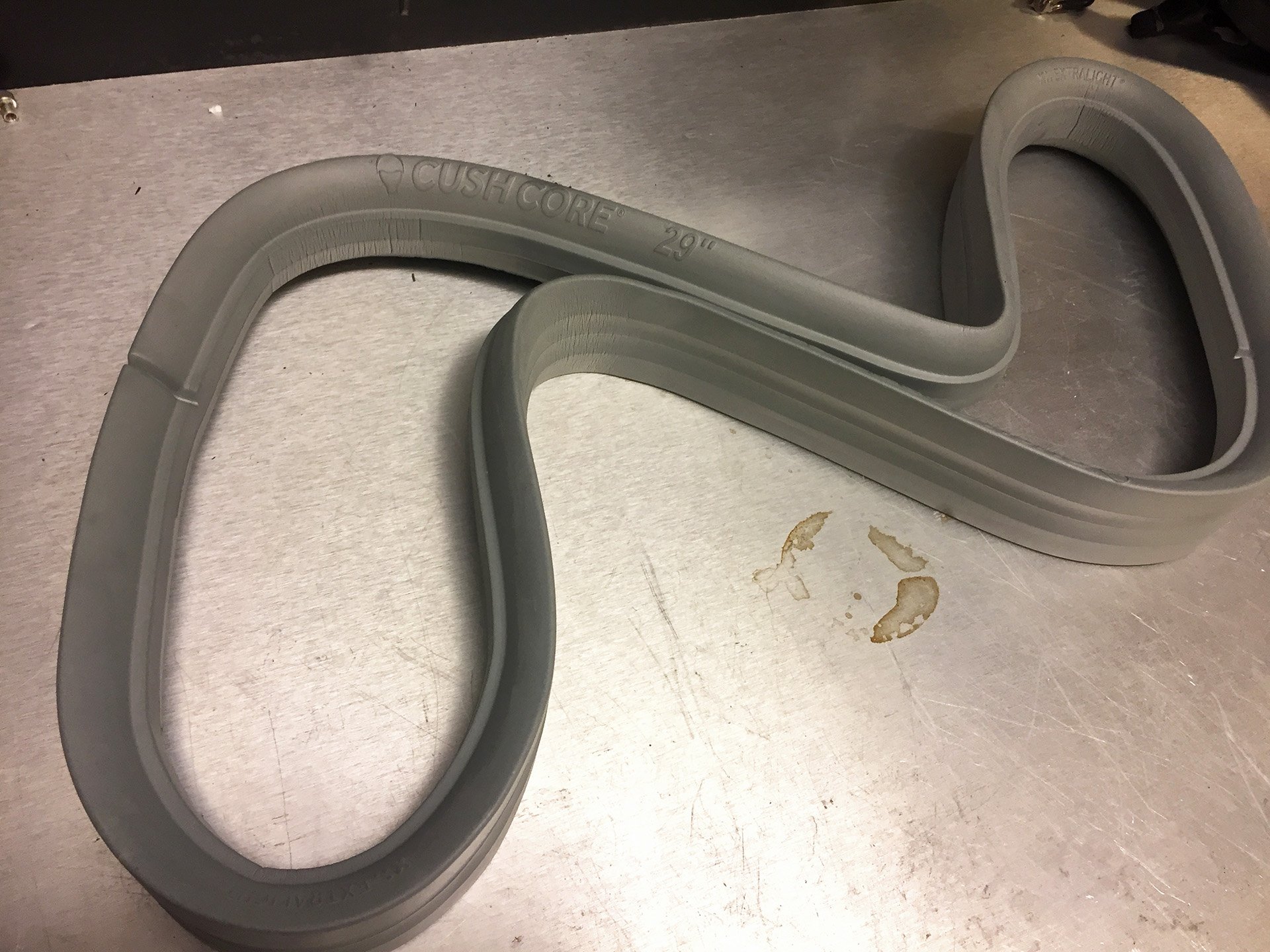
Here's what our Cushcore looked like fresh out of the box. Like the intestine of some plastic eating Star Wars character.
Cushcore, like Flat Tire Defender, requires a proprietary valve stem so the insert doesn't block air or fluid entry. This stem isn't very long (35mm) and the Bontrager rims have a deep cross section. I reasoned that if I could chop away the built up plastic area around the valve hole I might be able to use these wheels for my Cushcore test. I started by cutting with a knife and I made some progress, but not enough. I had a beer and some dinner and decided this was a job for power tools. Without measuring I grabbed the largest drill bit that was close at hand. I wanted to shave away some material but not go right through and compromise the seal. Everything was going fine... and then I pushed right through the valve hole. I figured I had destroyed the rims because that's the sort of thing I do with alarming regularity. Alas - I managed to get just enough extra space for the valve stem to fit and it seems that I didn't enlarge the valve hole. (Note - Cushcore has 55mm stems on the way. Ed.)
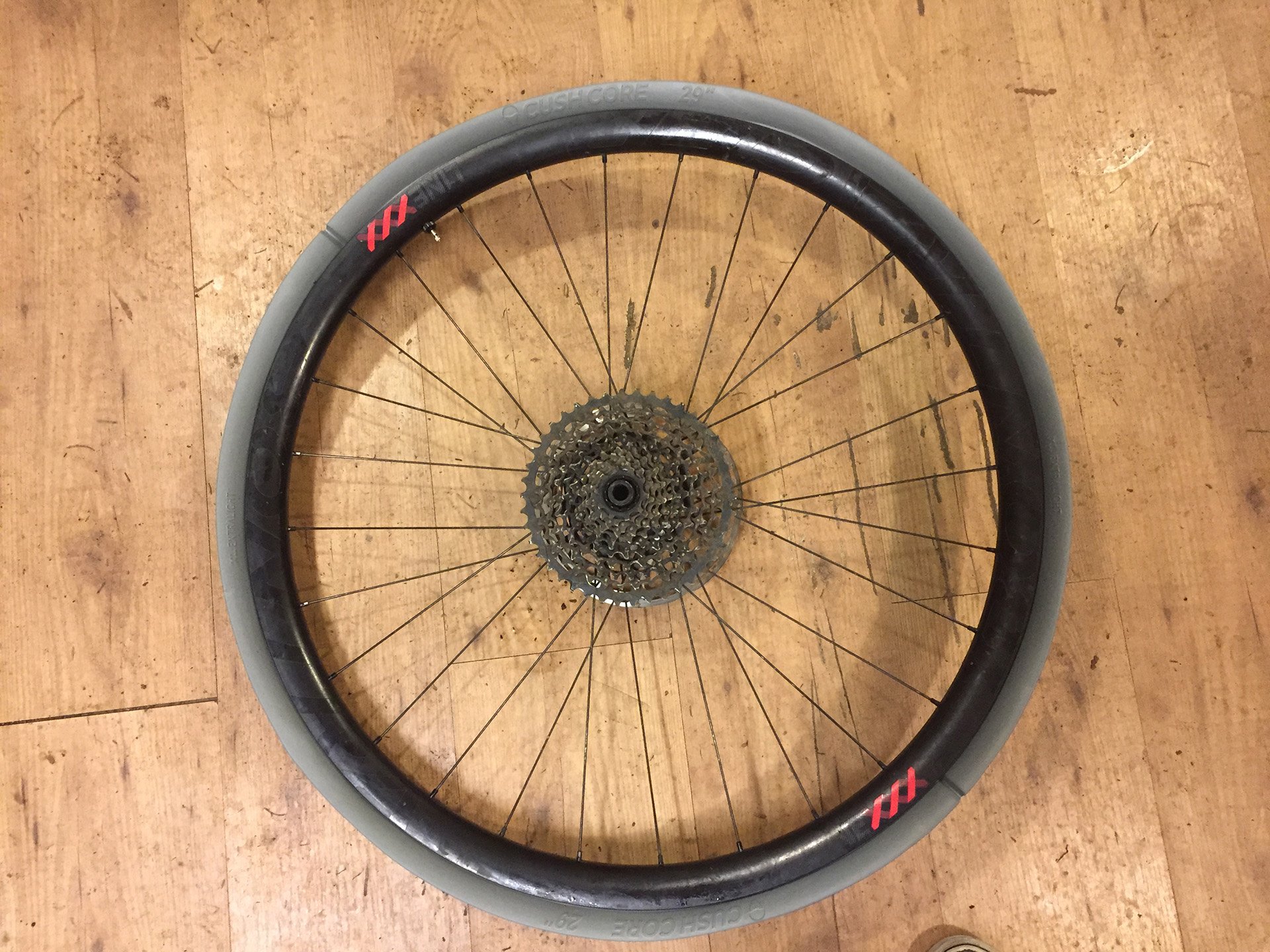
"CushCore is made from a unique injection molded polyolefin foam technology. After extensive research and testing on over 50 materials, the CushCore team selected this closed cell foam for its outstanding combination of low weight, extreme durability, and shock absorbing capabilities. The material is waterproof and impervious to tire sealant. CushCore inserts are manufactured to tightly controlled quality control standards." - Cushcore website.
And now the main event. It was time for me to mount the inserts and then get in the ring with a 29 x 2.3 Maxxis Minion DHR II. The first step is to mount the Cushcore around the rim. This was easy enough but I knew the fun was yet to come. Then the trick is to wrap the tire around the insert so that it is surrounded by unmounted tire. This was a bit of a chore but again, not too bad.
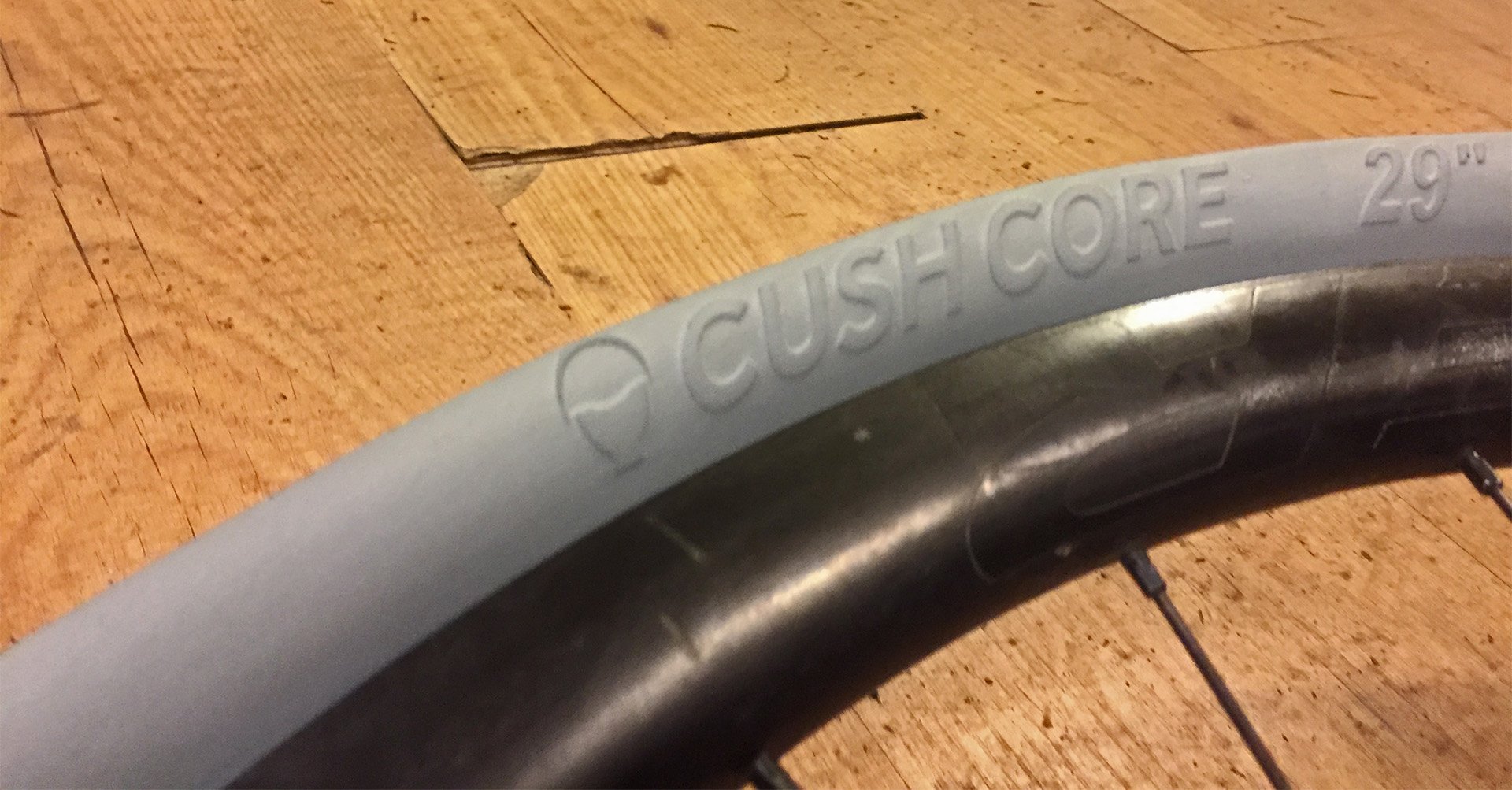
Just squeeze the tire bead into all that space that's left... This part was tricky and I forgot to use any bead lube like Uncle Dick's Bead Slip.
The next step is to install one side of the bead. Getting started was a little tricky and after that, the process involved driving the bead as deep into the space between the insert and the rim as possible and working both sides around to get a little more space. That last bit was tough and if I two-handed one side the other side would slip off. After about ten minutes of massaging, I got it. Starting the second side was actually much easier than the first with the tire having some shape, but the last 8 inch gap was a battle royale using the same procedure as the first side. In total, I got 'er done in about 30 minutes for the first wheel - including adding sealant through the valve hole.
As usual with these solutions, this is a good news-bad news proposition. Our examples weigh 260g apiece in 29 and 250g in 27. Adding over a pound of rolling weight to your bike is nobody's idea of a performance advantage, but Cushcore suggest that you are able to use lighter tires and rims because of the protection the product offers so that in the end you may even be able to save weight. We'll call that part 2 of the test. For now I'm using the same rims and tires.
Price
- US$149 for 2 valves and two inserts
COMPATIBILITY
- CushCore is only compatible with current tubeless tires and rims
- Fits tire widths 2.1 - 2.5"
- Fits rims with internal width 23 - 35mm
- Sealant is recommended
WEIGHT
- 29" insert - 260 grams
- 27.5" insert - 250 grams
- Potential weight reduction offset by using lighter tires and rims: 100-700 grams
- More good news is that, barring catastrophic events, it shouldn't be necessary to swap these out on the trail. It seems to me that these will hold their shape and ride well without any air pressure at all and I intend to try that out.
Cushcore is a small Bend Oregon company. Check them out at Cushcore.com.







Comments
WNCmotard
7 years, 1 month ago
That's over a pound of weight, at the one place you'll feel it the most.
Reply
Znarf
7 years, 1 month ago
Procore actually DOES help against burping and rolling, contrary to what the Cushcore chart says. It's also lighter AND it does protect against pinch flats.
But Cushcore doesn't look bad, too. Especially for park bikes it might be a low maintenance option.
Their website however states, that it should be swapped for a new foam ring every two tires. It has a "service life" as most other performance products, or so the website says.
If you ride a lot, that's not a lot of product life for a 149$.
Not destroying your rims constantly saves a lot of $ though. So maybe it's not that expensive.
Reply
Pete Roggeman
7 years, 1 month ago
If you're going to Cush Core, best to call a friend first.
Reply
ExtraSpecialandBitter
7 years, 1 month ago
Well they lost all of my respect when I realized how far away the Schwalbe logo is from the valve stem. Definitely not detail oriented.
Reply
Michael McCallum
7 years, 1 month ago
Ok I now have a couple rides on the cushcore but only in the rear wheel. I need a longer valve stem for the front rim. I started out at 18psi and worked my way down to 14psi. I found 15-16 psi to be my sweet spot for now. I can still make it swish a bit when in the saddle on a big G-out turn but it isn't an issue. You just feel the squish. No burp and definitely no rim strikes. It's pretty surprising actually since you expect the tire to just come off the rim but here Cushcore really supports the sidewalks well. Today I took it down a very rocky course with sharp edges and lots of speed is carried on this trail. The best description I can give is that it has a "dead" feel. And that is a good think. It just slams into stuff and doesn't blink. No deflection. No rim strikes. And the tire held up well (ikon 2.3). I feel it helps to know what people are riding when they comment. I was on a Santa Cruz Hightower in the 29" version.
Reply
Gille Briand
7 years, 1 month ago
How much do you weight and what pressure did you run before installing cushcore? Did you lower your tire pressure just to test the system or did you just enjoy the extra grip?
I was curious if the ride would get harsher for the same pressure due to the lower volume inside the tire and had to compensate with lower pressure?
Thanks for the quick review, very usefull
Reply
Cr4w
7 years, 1 month ago
I wonder if half the protection would be worth it to save half that 260g?
Reply
Cam McRae
7 years, 1 month ago
I'm not sure what you are saying Cr4w.
Reply
Cr4w
7 years, 1 month ago
Adding 260g to the outside of your wheel, especially a 29", is a lot.
What if they shrunk this product down to just, say, 130g. Just made it a little less tall or a little less wide - would that still provide enough added protection to be worth it?
Reply
Sven Luebke
7 years, 1 month ago
None of these do-hickies stop my tires from losing air when they sit in the basement. That's what I'd like to improve on tubeless.
Reply
Michael McCallum
7 years, 1 month ago
Disclaimer: I haven't ridden the cushcore yet but I have installed it.
Things to note, the valves are short for those tall carbon rims out there but the longer ones are on their way. The current valves work well with most rims though as long as they are not too tall.
The installation process is tricky at first but once you get the hang of it you can install the entire system in a matter of minutes. Just follow the video closely the first time. I found that it is very important to lube up the bead and really sink it down in the rim so as to give plenty of room to pull that last 8" over the rim. Once the tire sealant is in the system any further tire changes are much easier since the sealant acts as a good lube.
When removing a tire you must do the same. Really push that bead down into the rim to make room for the tire to be pulled out over the rim.
Must first tire sealed up super tight without sealant the first time. It also held the air without leaking at all. It made me wonder if I even needed sealant. But I would still recommend the sealant. Plus it makes any future tire changes much easier.
First ride will be this evening under the full moon. Stay tuned.
Reply
Michael McCallum
7 years, 1 month ago
I hope to compare it to the Huck Norris and the Procore soon. 2 riding buddies are these.
Reply
Michael McCallum
7 years, 1 month ago
Gille, I ran 24-26psi in the rear tire with a tubeless setup prior to Cushcore. I found that I would pinch flat or even tear a sidewall if I went any lower. I weigh 175-180 lbs. I lowered the pressure as a test and found that the cushcore provided much more support than without. The ride is not harsh at all. Very dead feeling with expect to vibration and strikes. Lots of sidewall support.
Installing the system is tricky but once you figure it out (follow that video exactly) it isn't difficult. But removing the tire is tough depending on your rim and how snug your bead is fixed to the rim. You really need to follow the installation approach closely but in reverse. Use a bucket or trash can and get some hefty tire irons or tools to push the bead down in the rim. My bead was really fixed to the rim but once I broke it loose it was easy.
Reply
Gille Briand
7 years, 1 month ago
Thanks for the feedback.
Do you feel the foam will be durable enough without the rim cutting trough it on impacts? Do you expect it to last at least a full season? Too expensive to be disposable.
Did you feel any differences in respect to rolling resistance? I am debating going exo sidewall + cushcore or DD casing without additional inserts ( for ease of install/removal), your toughts?
Reply
Michael McCallum
7 years, 1 month ago
I don't think the rim can cut through the insert. It's sort of a dense material. But amazingly light weight for its density. I don't know how long it will last but I'd be surprised if it didn't last an entire season.
I am on 2.3 with EXO.
Reply
ihersom
6 years, 10 months ago
So turns out you can create a similar system using closed cell air conditioning foam insulation, I've been riding on it for about a week and it feels great, about the same as all the claims about increasing damping and such. If anyone is interested in getting setup with a similar system to CushCore or Flat Tire Defender for under $15 as opposed at least $100 for those systems, let me know and I can create a DIY video. It seems to good to be true, and my DIY version may be 70% of what the big guys are producing, but if you can get 70% of the performance for about 12% of the cost, totally worth it.
Reply
HardtailCanada
3 years, 3 months ago
For anyone in the market for Cushcore, both of NSMB's articles on the topic are great and in line with my experience so far.
If readers want a different take, or one focused on a heavier rider on a hardtail, check out my article--Cushcore Review: How it Lives Up to the Hype.
But, like many riders here, I'm keen to learn more about the product's long term durability.
Reply
Please log in to leave a comment.